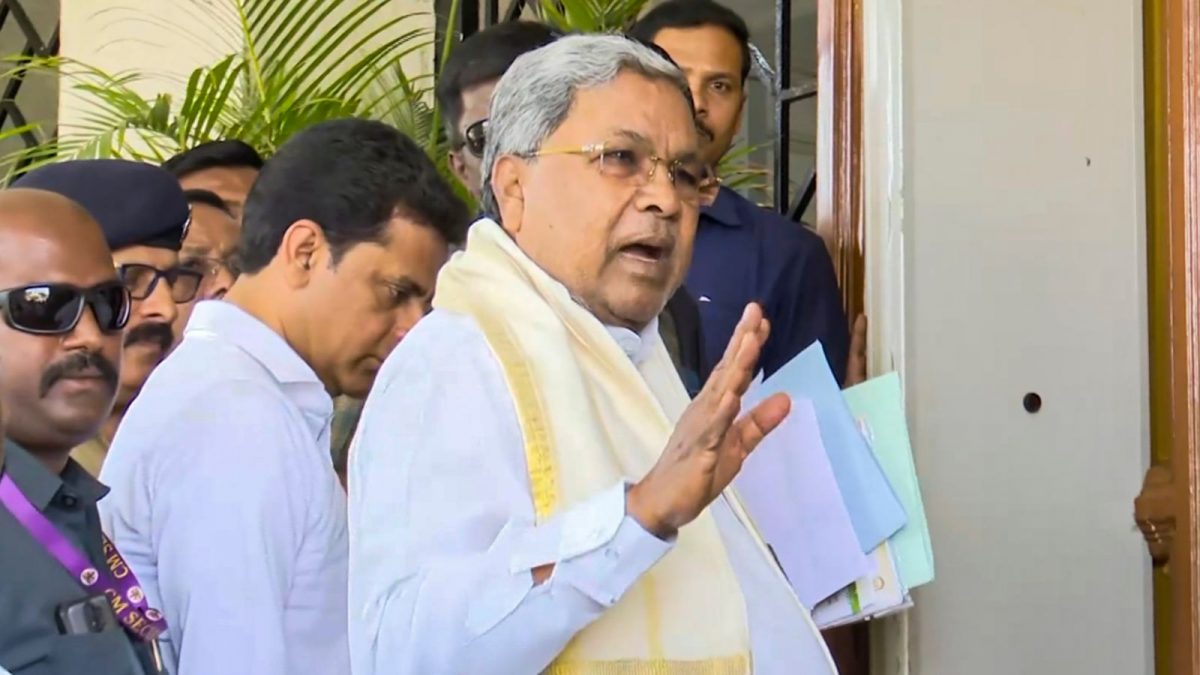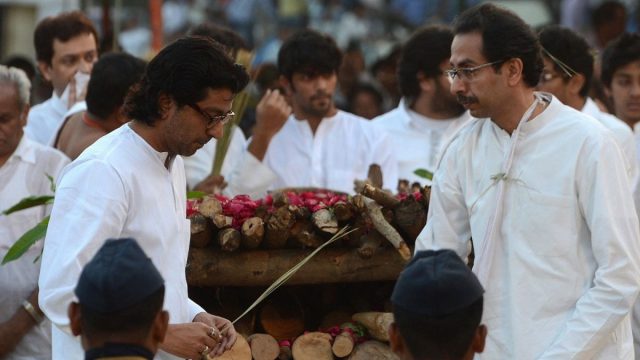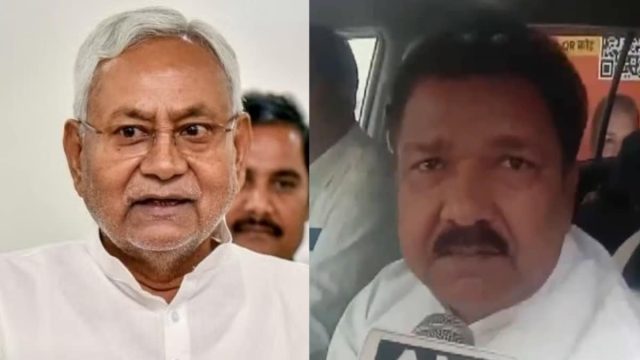Last Updated:
The cabinet and Congress leadership will mark two years in power with a ‘Sadhana Samavesha’—a public rally aimed at highlighting the government’s achievements

For Siddaramaiah, the Hosapete rally is a public pitch for continuity and a show of strength to the Congress high command in Delhi. (PTI)
Incessant rains have brought Bengaluru to its knees. The same city that Karnataka proudly flaunts as contributing over 43.65 per cent to the state’s economy is now reeling under floodwaters. But as the capital drowns, the ruling Congress government has chosen to shift focus—away from crisis and towards celebration.
The entire Siddaramaiah cabinet and Congress leadership have landed in Hosapete to mark two years in power with a ‘Sadhana Samavesha’—a public rally aimed at highlighting the Congress government’s achievements. Being held in the newly formed Vijayanagara district, the event is being portrayed as a “guarantee rally,” with the government claiming it has spent Rs 80,000 crore on its five flagship schemes—one of the main poll planks on which it came to power in the state.
Siddaramaiah’s report card is a sweet-and-sour mix. The welfare push through the guarantees has been the centrepiece of the government’s pitch to voters in 2023—and has been delivered effectively, says the Congress.
The Congress came to power on the twin promises of clean governance (anti-corruption) and welfare. Two years in, the welfare delivery has been seen as successful. But the clean image as well as development have taken a beating.
The past year may well have been the most challenging 12 months of Siddaramaiah’s two terms as chief minister. This term, Siddaramaiah’s second stint as chief minister of Karnataka, has also been marred by corruption scandals, internal power tussles, and a governance gap that’s glaringly visible in Bengaluru.
Back in Bengaluru, the ongoing rain fury has left three people dead, over 500 homes flooded, and many neighbourhoods submerged. Poor drainage has paralysed infrastructure, submerged underpasses, and created traffic snarls stretching kilometres.
When asked about the crisis, Siddaramaiah and his deputy, Shivakumar, downplayed concerns: “We cannot control rains or nature,” he told News18, “but we can ensure people’s safety, and that is being done by the agencies.” He added that a city-wide tour was planned for May 21 to assess the damage.
But for the chief minister, the Hosapete rally is more than just a celebration—it’s a statement. It is a public pitch for continuity, a show of strength to the Congress high command in Delhi, and an assertion that he remains the best candidate to complete the government’s full term.
Political scientist Sandeep Shastri said Siddaramaiah has pushed forward the promises the party made in the last elections. “But this term, he’s had to deal with corruption allegations—something he hadn’t faced in the past. That’s been a major setback. Responding to those charges has dented his image and slowed him down. He’s had to spend more time firefighting than governing,” said Shastri.
That term, however, hangs on a delicate power-sharing equation. When the Congress returned to power in 2023, it was said that under an “unwritten understanding” between Siddaramaiah and DK Shivakumar, a 2.5-year split of the chief ministership was agreed upon to end the standoff between their factions.
Shastri adds: “Regardless of whether there was a formal agreement on a power-sharing deal, it is imperative for the chief minister to show what was promised and what has been delivered. The additional challenge is that there’s talk about him having to make way for someone else. That makes it all the more necessary for him to justify his performance over these two years—and, indirectly, argue why he should continue.”
Siddaramaiah was seen as the main face of the election campaign in 2023; Shivakumar, as the state party president, was its engine—mobilising grassroots support and building the party’s state-wide machinery. Their popularity as leaders helped pull the party across the victory line, with a thumping success of 135 seats out of 224 assembly seats in Karnataka.
As the halfway mark approaches, Shivakumar has been tugging every string in Delhi to remind the party of that pact. Siddaramaiah, meanwhile, has been working hard to present a performance strong enough to justify his governance.
Siddaramaiah is also a chief minister who declared that the 2023 election would be his last. That has only fuelled speculation that Shivakumar could be next in line to lead the Congress in Karnataka.
But for now, Siddaramaiah remains firmly in charge. In March 2025, he presented his 16th budget—more than any CM in the state’s history. With over seven years in office across two terms, he is inching close to surpassing D Devaraj Urs as Karnataka’s longest-serving chief minister.
Unlike his relatively unblemished first term from 2013 to 2018, Siddaramaiah’s second innings has unfolded under constant oversight from the Congress high command. From key decisions to damage control, he has been in frequent consultation with party president Mallikarjun Kharge and leader Rahul Gandhi.
However, Shivakumar’s USP is as the man with organisational skills. One who also brought the Congress to power even in neighbouring Telangana—an organisation man who will lead the party from the front. As one Congress leader from the Shivakumar camp said, “This is the time for Shivakumar to assert and get his chance to become chief minister. That will pave the way for the next election for the Congress to win again, as he will lead it like a general from the frontlines.”
Despite the setbacks, Siddaramaiah’s camp continues to push the “Karnataka Model”—a blend of welfarism, social justice, and fiscal management—as a blueprint that other states have followed as his USP.
At the core of Siddaramaiah’s administration are the five guarantee schemes—Gruha Lakshmi, Shakti, Gruha Jyoti, Anna Bhagya, and Yuva Nidhi. Despite questions around financial sustainability, these schemes have had clear on-ground impact, especially among women, the unemployed, and low-income groups. Their success helped the Congress bag nine Lok Sabha seats in Karnataka in 2024 (up from one in 2019 parliamentary polls), and sweep three assembly bypolls.
“It is the guarantees that have given people disposable income in their hands. It empowers them, brings them back to their feet and today we are able to build a stronger state. That is what the guarantees have done—they have guaranteed people their right to life, food, access to medicines and employment. That’s what a welfare government does and what Siddaramaiah’s government stands for,” said labour minister Santosh Lad to News18.
Still, the past two years have been riddled with turbulence—and that certainly has rocked Siddaramaiah’s boat.
The most damaging controversy has been the MUDA land allotment case, which was personal to Siddaramaiah. For a politician who did not want his political career to be blemished with corruption charges, the MUDA case certainly dented his image. The scandal involved residential sites in Mysuru being allocated to Siddaramaiah’s wife. Though she returned the sites, the political damage was done. The Governor’s decision to sanction prosecution against Siddaramaiah in the case opened a fresh battlefront between the Raj Bhavan and the government.
Almost simultaneously, the Valmiki Corporation scam rocked the state. Crores meant for tribal welfare were siphoned off to private accounts—a racket that came to light only after a corporation employee died by suicide, leaving behind a note. ST welfare minister B Nagendra was forced to resign and was later arrested by the Enforcement Directorate. An SIT was formed and recovery was initiated.
Then came another embarrassment. Cooperation minister KN Rajanna claimed nearly 50 politicians had been honey-trapped, including himself. The dramatic revelation dominated headlines, but two months on, there’s little to show for it—further denting the government’s credibility.
The administration’s fatigue is most evident in Bengaluru. Despite big-ticket announcements like tunnel roads and sky decks, the city is still buried under garbage, potholes, broken footpaths, and a crumbling civic system. Shivakumar, who handles the Bengaluru Development portfolio, has promised sweeping reforms—but the ground reality remains unchanged.
The government has pitched the Greater Bengaluru Governance Act (GBGA) as a structural fix—proposing to break BBMP into smaller zones and bring both the CM and DyCM into more direct control. But whether this bureaucratic rejig will translate into results is still unclear.
Even Siddaramaiah’s statements during the Pahalgam incident—saying that war was not needed—were seen as a faux pas and have embarrassed the party.
Shastri said one should understand that Siddaramaiah is not a dyed-in-the-wool Congressman. “He has his own approach and his own style—and sometimes that style may not always align with what the party needs. I think there’s definitely discomfort about it, and it’s visible,” he said.
All this has kept the government in constant firefighting mode. Siddaramaiah has worked to maintain his grip, while Shivakumar continues to safeguard his position as KPCC chief. But the bruises have been real.
On the Congress high command’s strategy, Shastri says: “The high command has other problems to deal with. They’re facing bigger challenges at the national level. So, managing a state where they’re already in power might not seem like a priority to them.”
While he thinks that is not the right approach, and the fact they should be focused on retaining every state they hold, “it appears they are more preoccupied with the broader picture”, he said.
So, will there be a handover of power? “That is the million-dollar question,” says PS Jayaramu, another political commentator and former Dean, Faculty of Arts at Bangalore University.
As a keen observer of politics, he said, “Because all we know is that there was some kind of secret understanding between Shivakumar and Sonia Gandhi—that she would support him in becoming chief minister after two-and-a-half years. But we don’t have anything authentic on record. It remains speculative, yet politically potent.”
What complicates matters further is the role of Rahul Gandhi. Though Sonia may have brokered the initial truce, Rahul’s voice now holds more sway in organisational matters. His views on leadership transition in Karnataka remain unclear—and that ambiguity is allowing the suspense to build, adds Jayaramu.
“Other part is, you know, Rahul Gandhi, who matters a lot in the Congress party in terms of decision-making—he is reportedly in favour of Siddaramaiah. So that strengthens Siddaramaiah’s case. Plus, the achievements which the Congress government claims—achievements by the implementation of the guarantees—will also help him stand in good stead to continue in office. So the odds are in favour of Siddaramaiah for now. But then, Shivakumar also will not keep quiet. He might come up with some overtures which might shake the party leadership,” he explained.
- First Published:




